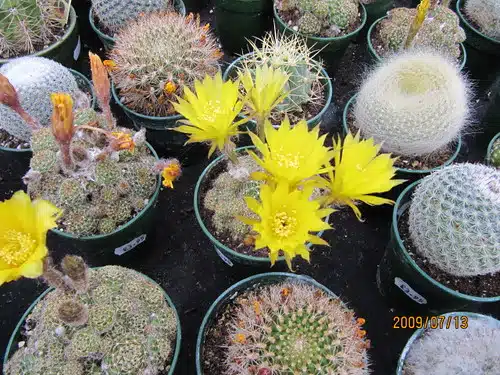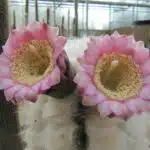Crown cactus, also known as Rebutia cacti, are a fascinating and beautiful addition to any cactus collection. These small cacti feature bright flowers that bloom in a range of colors from pink to red and yellow. Crown cacti are native to Bolivia and Argentina, where they grow in high-altitude areas with rocky terrain.
As a horticulturist specializing in cacti, I have found that growing crown cactus can be a rewarding experience for both beginners and experienced gardeners alike. With proper care and attention, these compact plants can thrive indoors or outdoors in warmer climates. In this article, we will explore the basics of growing crown cactus, including their preferred growing conditions, propagation methods, and common pests to watch out for. Whether you are new to gardening or a seasoned expert looking for a new challenge, learning how to cultivate crown cactus is sure to provide hours of enjoyment and satisfaction.
Overview Of Crown Cactus
Crown cactus, also known as Rebutia cacti, is a popular and beloved species among the cacti enthusiasts. This small-sized plant is native to South America, particularly in Bolivia and Argentina. The crown cactus belongs to the family of Cactaceae, which comprises more than 2,000 different species of cacti.
Crown cactus is an easy-to-grow plant that requires minimal care, making it an ideal choice for beginners. These plants can grow up to three inches tall and six inches wide, with bright colored flowers that bloom in spring or summer. However, taking care of this species requires some essential tips that every owner should be aware of.
To ensure the healthy growth of crown cactus, the plant requires well-draining soil that does not retain excess water. Overwatering can lead to root rot or fungal diseases that may cause irreversible damage to the plant. Additionally, these plants love sunlight but cannot tolerate extreme heat exposure. Therefore, it’s best to place them in partially shaded areas where they can receive enough light without getting scorched by the sun’s rays.
History And Origin Of Rebutia Cacti
Cactus Origins can be traced back to millions of years ago when the earth’s climate was much different than what it is today. The early ancestors of cacti were believed to have originated from Africa and Madagascar. Over time, they spread out to other parts of the world such as North and South America.
Historical Cactus Evolution is fascinating as cacti have evolved over millions of years to adapt to their environment. They are known for their ability to survive in harsh conditions, where water is scarce and temperatures are extreme. The evolutionary process has resulted in various sizes, shapes, and colors amongst cacti species.
To paint a picture in your mind, imagine a barren desert landscape with scattered rock formations. In between these rocks grow small cylindrical plants adorned with spines that act as a defense mechanism against predators. Some species produce vibrant flowers that attract pollinators like bees and birds. Others develop juicy fruit that serves as food for animals.
Moving on from the origin story of Rebutia Cacti, we will now explore their unique characteristics that make them stand out from other cacti species.
Characteristics Of Crown Cactus
Crown cactus, scientifically known as Rebutia Krainziana, is a popular cactus species due to its vibrant colors and easy care requirements. The plant can grow up to 10 centimeters in height and produce small, cylindrical stems that cluster together. Crown cacti are native to Bolivia but have become popular among horticulturists worldwide.
One of the most notable characteristics of Crown cactus is its bright coloration. The plant produces flowers that range from red to pink or yellow, which bloom during the spring and summer months. Additionally, the stem texture is ribbed with small tubercles that add to its overall aesthetic appeal. Due to its small size, it is ideal for indoor cultivation.
Caring for crown cactus is relatively easy, making it an excellent choice for beginners. The plant requires well-draining soil and should be watered once every two weeks during the growing season. During winter dormancy, watering should be reduced to once a month. Crown cacti thrive in bright sunlight but can tolerate partial shade if necessary. It’s important not to overwater the plant as this can lead to root rot or fungal diseases.
| Characteristics | Tips |
|---|---|
| Bright colored flowers | Bloom during spring and summer |
| Small cylindrical stems | Cluster together |
| Ribbed stem texture | Adds aesthetic appeal |
| Easy care requirements | Requires well-draining soil and minimal watering |
With proper care, crown cactus can live for many years and provide an array of colorful blooms throughout their lifespan. As with all plants, it’s important to monitor for pests such as spider mites or mealybugs which can damage the plant’s health. In the next section, we will discuss different types of rebutia cacti that are closely related to crown cactus in both appearance and care requirements.
Types Of Rebutia Cacti
Rebutia is a genus of cacti, containing approximately 40 species, native to the Andes mountains of South America. Rebutia are characterized as small and globular with a crown of spines. Proper growing conditions for Rebutia cacti include bright light, moderate water, and well-draining soil. Pruning to remove dead flower buds and old spines is an essential element of Rebutia cacti care.
Types Of Rebutia
As a cactus horticulturist, it is my pleasure to share with you the different types of Rebutia species that you can cultivate in your garden. Rebutia cacti are known for their bright and colorful flowers that bloom from spring to summer. There are approximately 40 species of Rebutia, and they are native to Bolivia and Argentina. These cacti are commonly referred to as crown cacti because of the way their spines grow around the top of the plant.
One type of Rebutia species that you may want to consider is the R. krainziana. This species has vibrant pink flowers that bloom in clusters during early summer. Another popular type is the R. heliosa, which has yellow or orange flowers that bloom in early spring. If you’re looking for a unique addition to your collection, you may want to try cultivating R. minuscula, which has small spherical stems and bright red flowers.
Aside from these pure species, there are also Rebutia hybrids available in the market today. These hybrids are created by crossing two different Rebutia species to produce new varieties with unique characteristics. One example of a hybrid is the R. xanthocarpa, which was produced by crossing R. marsoneri and R. krainziana. This hybrid produces golden-yellow flowers with red centers and is known for its large blooms.
In conclusion, knowing the different types of Rebutia species and hybrids can help you choose which ones will best suit your garden’s needs and aesthetics. Whether you prefer vibrant pinks or sunny yellows, there’s a Rebutia cactus out there for everyone!
Growing Rebutia
As a cactus horticulturist, it is essential to know not only the different types of Rebutia species but also how to grow them successfully. Proper plant care and soil mixtures are vital in keeping these cacti healthy and thriving. When it comes to growing Rebutia, it’s important to remember that they prefer well-draining soil with a slightly acidic pH level. A suitable soil mixture for Rebutia can be created by mixing coarse sand, perlite or pumice, and regular potting soil in equal parts.
In addition to the right soil mixtures, Rebutia plants require specific care to ensure their growth and health. These cacti enjoy bright, indirect sunlight and are sensitive to extreme temperatures. Overwatering can also be detrimental to their growth, so it’s best to let the soil dry out between waterings. Fertilizing your Rebutia with a low-nitrogen fertilizer during the growing season can help promote blooming.
By following proper plant care techniques and using suitable soil mixtures, you can cultivate healthy and vibrant Rebutia cacti. Whether you’re starting with pure species or experimenting with hybrids, these plants are sure to add beauty and uniqueness to any garden setting. As a cactus horticulturist, my goal is always to serve others by providing knowledge and guidance on how they can achieve success in their gardening endeavors.
Choosing The Right Pot And Soil
When it comes to growing crown cactus, choosing the right pot and soil is crucial for a healthy plant. The size of the pot should be proportional to the size of the plant, allowing for enough space for growth and development. A small pot may restrict root growth, while a large pot can lead to overwatering and root rot.
In terms of soil composition, a well-draining mix is essential. Crown cacti prefer a mix with a high percentage of sand or perlite, which allows excess water to drain away from the roots. Adding organic matter such as peat moss or compost can improve soil structure and provide nutrients for the plant.
When selecting a pot, consider the material as well. Clay pots are porous and allow air exchange between roots and environment, promoting healthy growth. Plastic pots retain moisture better but may not offer adequate drainage unless they have drainage holes. Ultimately, choose a pot that accommodates the size of your crown cactus while providing good drainage.
Moving on to soil composition, it’s important to avoid heavy soils that retain too much moisture as this can lead to root rot. Instead, opt for lighter mixes made up of coarse sand or perlite combined with peat moss or coconut coir. This type of mix will allow for proper drainage while also providing enough nutrients for healthy growth. By selecting the appropriate pot size and soil composition for your crown cactus, you’ll be setting yourself up for success in keeping your plant thriving in its new home.
Transitioning into watering and fertilizing crown cactus, it’s important to keep in mind that these plants thrive in dry conditions and do not require frequent watering or fertilization.
Watering And Fertilizing Crown Cactus
After choosing the right pot and soil for your crown cactus, it’s time to learn about watering techniques and fertilizing schedules. Watering your crown cactus can be tricky as it requires a balance between not overwatering and not underwatering. The best way to water your crown cactus is to wait until the top inch of soil is dry before watering again. This ensures that the roots do not become waterlogged, which can lead to root rot.
Fertilizing your crown cactus is also important for its growth and health. A good fertilizer schedule for a crown cactus is one that is low in nitrogen but high in phosphorus and potassium. This type of fertilizer promotes healthy root growth and strong blooms. It is recommended to fertilize your crown cactus once every two weeks during its growing season, which is typically from spring to fall.
Proper watering techniques and a consistent fertilizing schedule are key components in maintaining a healthy crown cactus. However, it is important to note that light and temperature requirements also play a crucial role in its overall well-being. In order for your crown cactus to thrive, it needs bright indirect sunlight and temperatures ranging from 60-85°F (15-29°C). Understanding these requirements will help ensure that your crown cactus grows into a beautiful and healthy plant.
Light And Temperature Requirements
Light and Temperature Requirements:
Crown cacti, specifically the rebutia genus, have specific requirements for light and temperature in order to thrive. Indoor placement is recommended for these plants as they are sensitive to harsh sunlight and extreme temperature changes. An ideal location would be near a window that receives indirect sunlight or under artificial lighting that mimics natural light conditions.
Managing temperature is crucial for the survival of crown cacti. These plants prefer temperatures between 60-80°F during the day and slightly cooler temperatures at night. It is important to avoid placing them near any heat sources such as radiators or air conditioning vents. Sudden changes in temperature can cause stress on the plant and result in damage or death.
In order to maintain a healthy crown cactus, it is essential to monitor its light and temperature conditions regularly. Adjustments may need to be made depending on seasonal changes or any significant changes in indoor climate. By providing an appropriate environment, these fascinating cacti will flourish and continue to bring joy to any indoor space.
Transitioning into Propagation Techniques:
Now that we have discussed the necessary light and temperature requirements for crown cactus cultivation, it’s time to explore ways of propagating these plants.
Propagation Techniques
Propagation Techniques:
Ah, the joys of growing rebutia cacti. Nothing beats the satisfaction of watching them grow and thrive. But what if you want to share the love with friends or expand your collection? Fear not, for there are several propagation techniques you can use to multiply your crown cactus.
First up is water propagation. This method involves inserting a cutting into a container of water until roots form. It’s important to use clean water and change it frequently to prevent bacteria growth. Once roots appear, transfer the cutting into well-draining soil and wait for it to establish itself before watering as usual.
Division techniques involve separating offsets or pups from the mother plant and potting them individually. This allows each pup to develop its own root system and eventually mature into a full-grown cactus. Make sure to use a sharp, sterilized tool when making cuts and let the cuttings dry out before potting them up. With both these methods, patience is key as it may take several weeks or even months for new growth to appear.
Now that you know how to propagate your crown cactus, let’s move on to the next step: dealing with common pests and diseases.
Water propagation
Using rooting hormone
Monitoring water quality
Division techniques
Separating offsets vs pups
Timing for best results
As a cactus horticulturist, my goal is not only to grow beautiful plants but also to share my knowledge with others who have a similar passion for serving nature. These propagation techniques offer endless possibilities for expanding your collection or sharing your love of cacti with others. By mastering these methods, you will be able to nurture countless new plants from just one mother plant. So go forth and propagate!
Speaking of nurturing plants, it’s important to be aware of common pests and diseases that can threaten your precious cacti. Let’s delve deeper into this topic in the next section.
Common Pests And Diseases
It is crucial to understand that crown cacti, like all other plants, are susceptible to pests and diseases. Some common pests that can plague your crown cactus include spider mites, mealybugs, and scale insects. These insects feed on the plant’s sap, leading to stunted growth and yellowing of the leaves. Furthermore, if left untreated, these pests can cause severe damage to your crown cactus.
Fortunately, there are prevention measures you can take to avoid pest infestations in your crown cactus. One of the most effective ways is by ensuring proper sanitation practices in your garden. Regularly inspecting your plants and removing any debris or dead leaves will help reduce potential breeding sites for pests. Additionally, using organic insecticides such as neem oil or horticultural soap can help prevent pest infestations.
Treatment options for pest-infested crown cacti vary depending on the severity of the infestation. For a mild case of pest infestation, manually removing visible insects with a cotton swab dipped in rubbing alcohol may suffice. However, for more severe cases of infestations, systemic insecticides may be necessary. It is vital to follow treatment instructions carefully and avoid overuse since it can lead to toxicity issues in your plant.
Moving forward, preventing and treating pest infestations should be an integral part of your crown cactus care routine. In the subsequent section, we will delve deeper into some practical tips on how to prevent and treat different types of pest infestations effectively.
Preventing And Treating Pest Infestations
In order to maintain the health of crown cacti, it is important to be aware of common pests and diseases that may affect them. However, prevention is key in ensuring that these issues do not arise in the first place. Implementing preventive measures can significantly reduce the likelihood of a pest infestation or disease outbreak.
One effective preventive measure is maintaining a clean growing environment. This includes regularly removing dead or decaying plant material, as well as disinfecting any gardening tools used on the plants. Additionally, providing proper ventilation and avoiding overwatering can help prevent fungal growth and root rot.
If preventive measures fail and a pest infestation does occur, there are natural remedies that can be used instead of harsh chemicals. For example, neem oil is an effective insecticide for combating spider mites and scale insects. Alternatively, introducing natural predators such as ladybugs or lacewings can help control aphids and mealybugs.
To ensure the continued health of crown cacti, it is important to remain vigilant in preventing and treating pest infestations as they occur. By implementing preventive measures and utilizing natural remedies when necessary, gardeners can maintain healthy plants without relying on harmful chemicals. Next we will discuss the repotting process for crown cactus to further promote their growth and longevity.
Repotting Crown Cactus
When it comes to growing crown cactus, repotting is an essential part of the process. Repotting allows for proper root growth, which in turn promotes healthy plant growth. As a cactus horticulturist, I recommend repotting your crown cactus every two to three years or when you notice that the roots are outgrowing their container.
Repotting techniques vary depending on the size and age of your crown cactus. For smaller plants, gently remove the plant from its current container and assess the roots. If they are tightly packed, carefully loosen them before placing the plant into its new pot with fresh soil. For larger plants, it may be necessary to cut away some of the old soil and roots before replanting in a larger container with fresh soil.
Timing is crucial when it comes to repotting your crown cactus. The ideal time to repot is during its active growing season in spring or early summer when temperatures are warmer. Avoid repotting during winter months when the plant is dormant as it could cause unnecessary stress on the plant. Common mistakes when repotting include using too large of a container or overwatering after repotting. To avoid these mistakes, choose a pot only slightly larger than the previous one and water sparingly for several weeks after transplanting.
Moving forward with pruning and maintenance, it’s important to regularly check your crown cactus for any signs of disease or pests. In our next section, we’ll discuss how to properly prune and maintain your crown cactus to ensure its continued health and growth.
Pruning And Maintenance
Pruning and maintaining a crown cactus is essential to its growth and overall health. One of the benefits of pruning is that it helps to prevent overgrowth, which can lead to the cactus becoming too tall or wide for its container. When a crown cactus becomes too large for its pot, it can cause problems with drainage and soil stability, making it more difficult for the plant to absorb nutrients and water.
To prevent overgrowth, it is important to prune your crown cactus regularly. This involves removing any dead or damaged stems, as well as any branches that are growing in an awkward direction. By doing so, you will help the plant maintain its shape and size, while also promoting healthy growth.
Another benefit of pruning is that it stimulates new growth. When you remove old or damaged stems, the plant will redirect its energy towards producing new shoots and leaves. This will not only make your crown cactus look better but also encourage it to produce more flowers, which will enhance its overall beauty.
Preventing overgrowth and stimulating new growth are just two of the many benefits of pruning your crown cactus. By taking care of your plant in this way, you can ensure that it remains healthy and vibrant for years to come.
Transition: Now that we have discussed how to properly prune and maintain your crown cactus let’s move on to displaying this beautiful plant in your home or garden.
Displaying Crown Cactus
The crown cactus is a stunning plant that can add a touch of beauty to any room. With its unique texture and vivid colors, it is sure to evoke emotions of awe and wonder in anyone who sees it. Displaying this cactus can be a challenge, but with the right techniques, you can create creative arrangements that will showcase its beauty.
Here are four tips for displaying your crown cactus:
Choose an appropriate container: When choosing a container for your crown cactus, make sure it has good drainage and is the right size for your plant. A small pot might not provide enough room for your cactus to grow, while a large one could cause root rot.
Play with height: The crown cactus comes in different sizes, so use this to your advantage by creating a display with varying heights. Use taller plants or objects to create contrast and interest.
Mix and match textures: Pairing different textures together can create an eye-catching arrangement. Consider pairing your crown cactus with other plants or objects that have different textures such as wood or stone.
Use natural light: Crown cacti thrive in bright sunlight, so place them near windows where they will receive plenty of natural light.
With these tips in mind, you can create beautiful displays that showcase the unique beauty of the crown cactus. In the next section, we’ll discuss some tips for growing this plant indoors so you can continue to enjoy its beauty year-round.
Tips For Growing Crown Cactus Indoors
Growing crown cactus indoors can be a rewarding experience for those who enjoy indoor gardening. Indoor gardening has many benefits, such as improving air quality and reducing stress levels. To ensure the best results when growing crown cactus indoors, it is important to follow certain best practices.
Firstly, it is important to choose the right container for your crown cactus. The container should have drainage holes and be slightly larger than the root ball of the plant. This will allow for proper water drainage and prevent overwatering. Secondly, crown cacti require bright but indirect light to thrive indoors. Placing your plant near a sunny window or under a grow light can provide the necessary light without causing sunburn or scorching. Lastly, watering frequency is crucial when growing crown cactus indoors. These plants require well-draining soil and should only be watered when the soil is completely dry.
To help visualize these best practices, refer to the table below:
| Best Practices for Growing Crown Cactus Indoors | | — | — | | Choose a container with drainage holes | | Use well-draining soil | | Provide bright but indirect light | | Water only when soil is completely dry |
By following these best practices for growing crown cactus indoors, you can ensure that your plants will thrive and bring beauty to your indoor space. As an avid horticulturist, I recommend incorporating more indoor gardening into your life not only for the benefits it brings to your health and well-being but also for the joy of nurturing beautiful plants in your own home.
In conclusion, growing rebutia cacti can be a fulfilling hobby that brings numerous benefits to one’s health and living space. By implementing these best practices for indoor gardening, you can successfully grow beautiful crown cacti in your home while also enjoying all that indoor gardening has to offer.
Conclusion: Enjoying The Beauty Of Rebutia Cacti
After learning how to grow crown cactus indoors, it’s time to explore the beauty of rebutia cacti. These cacti are known for their bright and colorful flowers that bloom in the spring and summer months. They are also easy to care for, making them an excellent choice for beginners.
One of the benefits of growing rebutia cacti is that they come in a variety of colors and shapes. Some have spines while others have fluffy white hairs. The flowers range from reds and pinks to oranges and yellows. With so many options available, you can create a beautiful and diverse collection of these plants.
To display your rebutia cacti creatively, consider these ideas:
- Create a mini garden with multiple varieties in a shallow dish or tray.
- Use small pots with different heights to add dimension to your display.
- Place them on shelves or bookcases to add interest to any room.
- Use hanging baskets or macrame holders for a unique touch.
- Group them together with other succulents or cacti for a desert-inspired look.
With these creative ideas, you can enjoy the beauty of rebutia cacti while adding some greenery to your home decor. Remember to provide proper care, including well-draining soil, plenty of sunlight, and occasional watering, and your plants will thrive for years to come.
Conclusion
The Crown Cactus, also known as Rebutia Cacti, is a beautiful and unique addition to any indoor garden. These cacti are native to South America and have been cultivated for centuries. With their small size and stunning colors, Crown Cactus is an excellent choice for those who want to add some variety to their plant collection.
The characteristics of this cactus make it easy to care for, making it perfect for beginners. However, like all plants, they require proper attention and care to thrive. Choosing the right pot and soil, pruning and maintenance are essential factors in maintaining a healthy Crown Cactus plant. Displaying the cactus in an appropriate spot can also enhance its beauty.
Despite the ease of growing Crown Cactus, there is a theory that caring for plants can improve mental health. Studies have shown that interacting with nature can have positive effects on reducing stress levels and improving mood. Therefore, growing Crown Cactus not only adds beauty to your home but may also provide emotional benefits.
As a cactus horticulturist, I highly recommend including Crown Cactus in your indoor garden collection. Not only are they easy to care for, but they also offer numerous benefits such as reducing stress levels and enhancing mood. By following proper care techniques like choosing the right pot and soil, pruning regularly and displaying them in the right spot; you can enjoy these fascinating plants’ beauty for years to come.
Image Credits
- “Mixed cacti (Rebutia and Mammillaria)” by wallygrom (featured)





























